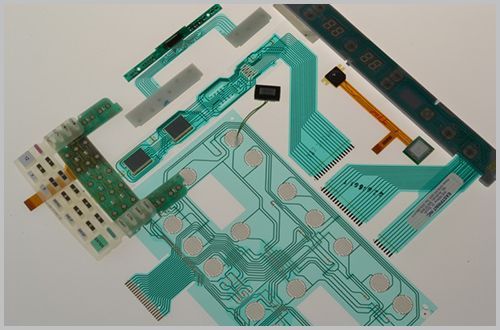
Membrane Switch Flexiable Circuit Printing is a Serious Procedure
When it comes to electric printing, there are a fair number of highly specialized niche areas. One of these unique applications is the printing of electric circuit for membrane switches. A membrane switch is an electrical contact on/off switch, that when pressed, activates or de-activates an electric circuit.
Membrane switch’s circuit is produced by screen printing the circuit directly onto the plastic substrate using silver or carbon conductive inks. Then these printed substrates should be treated through pass the dry oven, cutting random shapes according membrane switch application demands. This is membrane switch flexiable circuit printing.
Screen printing works well when there is a need for larger volumes or high-performance, functional graphics. However, digital printing appears to be a growing option in some areas.
One state that even though manufacturers use screen printing to print the circuits. Other components within the membrane switch can be printed through more advanced digital technologies, and in many cases. Such as PCB circuit printing for membrane switch, it is stiff panel and has more complex process.
Choosing Printing Inks and Substrate for Membrane Switch
The most common inks that the manufacturers use in the industry for membrane switches are solvent inks. They often purchase silver and carbon inks in common, because they think silver and carbon is good conductive material, and suit to print membrane switch circuit. However, printing ink made in China is unknown at all. In order to be ensure product has a good quality, engineers like choosing printing inks from Japan ,Germany and America etc. But also imported printing inks can have a strong adhesive power and more longer life span.
The substrate material for printing is selected ,Polyethylene Terephthalate (PET), Indium Tin Oxide (ITO) and polycarbonate, flexible substrates range from 0.005 to 0.010-inches thick. Although polyester is by far the choice for use in membrane switches, where we use polycarbonate and rigid vinyls for labels. This difference alone is significant in how the substrates are processed and techniques used to obtain maximum performance
Printing Quality of Conductive Inks
Taking into consideration of having a long life span of membrane switch when end user use it. We must be sure of the printing thickness of conductive ink is so enough. This makes metal domes scratched contact points connect the circuit contineously when press down a tactile button on the membrane switch. After a long time, the membrane switch has a not good touch in circuit connection. We promise customer the conductive inks is high quality and screen net is high through property. Thus ensure printing quality.
